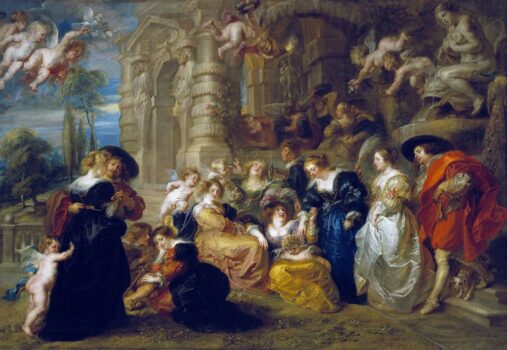The Garden of Love by Rubens: Meaning, Symbolism, and Analysis
Few works in European art capture the spirit of Baroque sensuality, festivity, and allegorical storytelling as powerfully as Peter Paul Rubens’ The Garden of Love (1630s). This luminous, celebratory painting brings together earthly love, divine blessing, social ritual, and artistic mastery into one vast tableau of figures, architecture, and mythological symbolism. To step into this canvas is to step into a theatrical stage of love itself, a mixture of reality, idealization, and allegory.
In this essay, we will explore the many dimensions of Rubens’ The Garden of Love: how it was painted, what it represents, its symbolism, its meaning, and where it resides today. We will analyze what is happening in the scene, the type of art it represents, and why it remains one of Rubens’ most enchanting works.
Peter Paul Rubens (1577–1640) was one of the towering figures of the Baroque era, renowned for his large-scale paintings filled with movement, grandeur, and sensuality. His oeuvre spans altarpieces, mythological scenes, portraits, and courtly commissions, but across genres, Rubens maintained a style that was vibrant, energetic, and lush with color.
By the 1630s, Rubens was at the height of his fame. He had traveled extensively through Italy, Spain, and France, absorbing the lessons of Renaissance and Baroque masters. He was not only a painter but also a diplomat and an intellectual, comfortable moving between royal courts as well as his studio in Antwerp. In 1630, Rubens remarried after the death of his first wife, Isabella Brant. His second wife, Hélène Fourment, was only sixteen at the time of their marriage (Rubens was fifty-three), but she became both his muse and inspiration for some of his most affectionate and personal works.
The Garden of Love is generally understood as a celebration of Rubens’ marriage to Hélène and of conjugal bliss. Painted around 1633–1635, it represents not just a general allegory of love but also a deeply personal testimony to the artist’s happiness in his later years.
How The Garden of Love Was Painted
Rubens painted The Garden of Love in oil on canvas, the medium in which he excelled. Measuring over two meters wide, the painting is expansive, designed to immerse viewers in a world of festivity and abundance.
His technique here is typical of his late style: broad, confident brushstrokes, luminous colors, and a mastery of texture. The silk gowns shimmer, the skin of the figures glows with vitality, the marble architecture feels solid, and the foliage breathes with life. Rubens’ handling of light plays a key role, sunlight filters through clouds and trees, casting soft illumination that unifies the entire scene in a warm, atmospheric glow.
The figures are painted in Rubens’ characteristic robust style: full-bodied, rounded, dynamic. The artist always celebrated the sensuousness of the human form, and here he emphasizes fullness and abundance to echo the theme of love and fertility.
What is also notable is the scale of the canvas and the density of its composition. Unlike the clear symmetry of Renaissance art, Rubens’ arrangement is Baroque in spirit, crowded, lively, filled with diagonals and flowing movements. Figures lean into one another, cupids fly about, fountains spurt water, and draperies flutter, creating a visual rhythm that conveys energy and joy.
What The Garden of Love Is About
The Garden of Love depicts a group of well-dressed men and women gathered in a lush, garden-like setting adorned with statues, fountains, and mythological motifs. The people appear engaged in courtship, conversation, and festivity. Cupids fly above, adding playful mischief and divine sanction.
But beyond the surface of aristocratic leisure, the painting conveys a deeper allegory: the sanctification of marriage and the joys of wedded love. The combination of earthly figures with divine presences suggests that Rubens was emphasizing not just sensual pleasures but also the blessed nature of conjugal union.
Some art historians have argued that the figures are modeled after Rubens himself and his wife Hélène. If true, then the painting is not merely an allegory but also a personal commemoration. In this sense, Rubens was merging the private and the universal, presenting his own marriage as a microcosm of divine and earthly love intertwined.
Symbolism in The Garden of Love
Rubens’ painting is packed with symbolic imagery that reinforces its themes. To interpret The Garden of Love, one must read it like a text of allegories:
1. The Cupids
The airborne cherubs and playful putti throughout the painting symbolize love’s presence and divine sanction. They shoot arrows, scatter flowers, and encourage union among the figures below. Their mischief reflects both the unpredictability of love and its inevitability.
2. The Fountain
The fountain in the center features a statue of Venus, the goddess of love, with doves at her side. Flowing water has long been a symbol of fertility, abundance, and life. By placing Venus at the heart of the scene, Rubens signals that love and fertility are the sources from which all joy in the garden springs.
3. The Statues
In addition to Venus, other mythological figures may be represented in the stone statues around the garden. These statues act as silent witnesses, linking the human revelry to the eternal themes of mythology.
4. The Garden Setting
The garden itself is highly symbolic. In European tradition, the “enclosed garden” (hortus conclusus) represented purity, often associated with the Virgin Mary. But here, the garden is more open and expansive, representing fecundity, abundance, and the pleasures of earthly life.
5. The Fashion and Dress
The elegant attire of the figures reflects aristocratic courtship rituals. However, the luxurious clothing is also symbolic of social status and dignity, Rubens elevates marriage not only as a personal union but as a socially esteemed bond.
6. The Doves
Associated with Venus, doves symbolize love, fidelity, and peace. Their presence underscores the theme of marital harmony.
In combining all of these motifs, Rubens creates a multi-layered allegory: earthly delight, divine approval, social order, and personal happiness coalesce into a single vision of love’s fullness.
What Is Happening in the Painting?
On the surface, The Garden of Love shows a group of well-dressed individuals enjoying themselves in an aristocratic garden. But each detail contributes to a larger narrative.
A man appears to court a woman, while others watch with amusement.
Cupids hover above, directing their arrows and gestures toward the couples.
A woman dressed in white seems to be the central female figure, possibly representing Hélène Fourment. She appears to be guided toward the fountain of Venus, as if symbolically entering the state of married love.
The architecture and statues frame the scene, elevating the garden into an allegorical stage.
The figures are not idle; they are actively engaging in flirtation, conversation, and companionship. The overall impression is one of movement, festivity, and vitality.
Rubens here is dramatizing not just an afternoon in the garden but the process of love itself: attraction, union, divine blessing, and communal celebration.
What Type of Art Is The Garden of Love?
The Garden of Love is quintessentially Baroque art. The Baroque style, which flourished in the 17th century, emphasized movement, emotion, grandeur, and theatricality. Compared to the balanced compositions of the Renaissance, Baroque paintings were dynamic and immersive, often designed to engage viewers emotionally.
Rubens was a master of Baroque exuberance. In The Garden of Love, we see:
Movement: Figures are arranged in diagonals and flowing curves, creating a sense of motion.
Emotion: The painting radiates joy, sensuality, and celebration.
Grandeur: The scale is monumental, the colors are rich, and the scene feels elevated above ordinary life.
Theatricality: The composition feels staged, almost like a performance unfolding in front of the viewer.
At the same time, the work belongs to the category of allegorical painting, where mythological and symbolic motifs are used to communicate ideas beyond literal representation. It is also, in part, a portrait group, if indeed Rubens and his wife are depicted, it doubles as a personal commemoration.
The Representation of Love
Rubens’ The Garden of Love does not depict love in a single dimension. Instead, it captures the many faces of love:
Romantic love: Through courtship and attraction.
Conjugal love: Through the reference to Venus and fertility.
Divine love: Through the blessing of cupids and mythological imagery.
Social love: Through the gathering of figures, showing marriage as a communal event.
What Rubens emphasizes is that love is abundant, overflowing, and joyous. The painting rejects asceticism and severity; instead, it embraces pleasure as a natural, even divine, part of human existence.
Where The Garden of Love Is Today
Today, The Garden of Love is housed in the Prado Museum (Museo del Prado) in Madrid, Spain. The Prado contains one of the finest collections of Rubens’ works, reflecting the artist’s close connection to the Spanish court.
The painting is one of the highlights of the museum’s Baroque collection, drawing countless visitors who are captivated by its size, vitality, and charm. To see it in person is to be enveloped by its warmth, as if entering the garden itself.
The Legacy of The Garden of Love
Rubens’ The Garden of Love remains one of the defining images of Baroque art not simply for its technical mastery but for its emotional resonance. It is at once personal and universal, mythological and realistic, playful and profound.
The painting celebrates the union of man and woman, but more than that, it celebrates life itself. In its abundance of figures, its richness of detail, and its glowing light, it embodies the Baroque spirit of vitality.
It also reflects Rubens’ own philosophy of art and life. Rubens believed in the beauty of the natural, the joy of the sensual, and the harmony between earthly and divine. In his garden of love, all of these come together, leaving us not only with a painting but with an enduring vision of human joy.
Peter Paul Rubens’ The Garden of Love is more than an aristocratic garden party on canvas, it is a visual hymn to love in all its forms. Painted with Rubens’ late mastery of color, texture, and form, the work draws together myth, symbolism, personal experience, and cultural ideals into a single radiant image.
Through its cupids, fountains, statues, and figures, it tells the story of love as both earthly pleasure and divine blessing. Through its lively composition and glowing colors, it invites viewers into its festive world. And through its presence today in the Prado Museum, it continues to remind us of the enduring power of art to celebrate life’s deepest joys.
In the end, to look upon The Garden of Love is to be reminded of Rubens himself: a man of immense energy, passion, and humanity, who painted not only for patrons and courts but also for the sheer delight of expressing life’s fullness. His garden remains open to us today, as timeless and welcoming as when he first painted it nearly four centuries ago.




